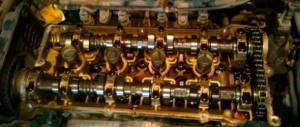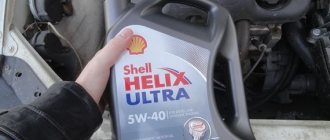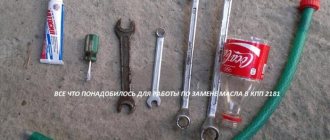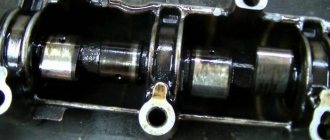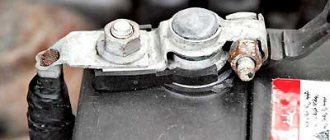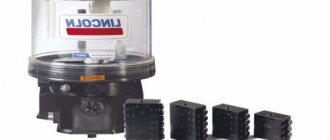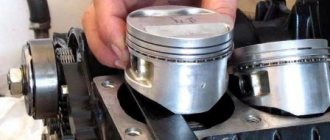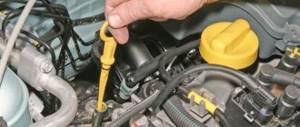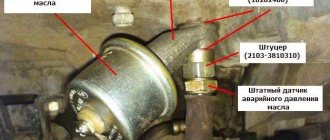Difficult conditions
However, in the service book there are reservations that operation in difficult conditions requires more frequent replacement. These include:
- driving at high speed;
- frequent trips in a busy metropolis in “start-stop” mode;
- off-road.
Despite the eternal Russian problem - bad roads - the main danger for cars in the middle zone of our country lies in traffic jams. Some car owners install an hour meter on their car and carry out routine maintenance based on the readings of this device. This approach is adopted when servicing outboard motors, jet skis, etc.
For example, a car travels 15 thousand km at an average speed of 50 km/h in 300 hours. This figure becomes the starting point. Then a car driving around a metropolis at a speed of 30 km/h must undergo maintenance after 9 thousand km.
The picture is even sadder for personal cars, whose drivers are constantly waiting for their boss with the engine running - it’s hot in summer and cold in winter. Based on technical logic, such cars need to be serviced every six months. And this is with minimal mileage! But this is usually not observed, so by the time of maintenance both the oil and the fuel system are not clean.
Washing methods and rules
Proper engine cleaning includes several stages. They are all equally important.
- Before carrying out the procedure, consult a specialist. He will point out the specific features of a particular power plant model.
- Carry out diagnostics of all engine mechanisms and subsystems.
- Properly drain and change the old fluid.
- Start the engine correctly after filling in new lubricant.
There may also be several processing methods. It is customary today to clean the engine with a special composition, regular oil, additives, etc. There are chemical, soft, full-volume and forced fluid flushes.
Chemical flushing
For some reason, some car enthusiasts believe that washing must be carried out using chemical compounds, although this is not the case. There is simply no panacea that can rid a motor installation of many years of deposits in just five minutes.
Chemical flushing is the use of a liquid that corrodes oil seals and seals. If the packaging says that the product is safe for rubber parts, it means that it is not aggressive enough, and such cleaning will not have an effect.
The use of a “five-minute” is also considered chemical treatment. These compounds, however, managed to gain notoriety and negative reviews. Motorists complain that after using them, the piston group of the unit is damaged.
Soft rinsing
It involves the use of flushing liquids whose composition is less aggressive. One of the well-known manufacturers of such a composition is THK. The product being released is called Promo Express. Suitable for washing not only gasoline, but also diesel power units.
Soft flushing is designed to cope with minor engine contamination. If the degree of deposits is too high, or the engine has not been washed for a long period of time, it is better to use other means.
Soft liquids contain solvents that dissolve contaminants. However, they do not change the viscosity of the lubricant. As a rule, it is recommended to drive no more than 200 km during soft washing. Then the fluid must be completely changed, filling with normal high-quality oil.
For information on using soft washing, watch the video from the author of Hi-Gear.
Full volume flushing
The essence of the method is that liquid with a large number of effective additives is poured into the pan. There are long-acting and “fifteen-minute” formulations. The first type of liquid is used extremely rarely today, the second is more common.
The essence of washing is similar to other cleaning methods. The liquid is mixed with the remaining contaminants, then it is all drained from the pan. It is mandatory to operate the engine in XX mode for fifteen minutes.
Engine flushing with forced fluid circulation
The best method of washing, as it involves the use of special professional equipment. Its operating principle is based on the use of pressure in the lubrication system, which doubles the cleaning effect.
The work boils down to the following.
- First, the oil filter is removed. The hose of the washing unit is threaded in its place.
- The other two equipment tubes are mounted on the oil filler neck and the crankcase drain hole.
- Washing liquid is poured into the unit.
- The equipment turns on, air pressure supplies flushing fluid into the lubrication system.
The engine cannot be started using this washing method. The liquid circulates through a filter located in the installation itself. As a result of such a run, dirt and deposits removed from the engine remain in it.
Rare trips
There is also a flip side to the coin. The manufacturer recommends changing the oil at least once a year. This is due to the fact that the lubricant, after being poured into the engine, begins to oxidize and gradually loses the necessary qualities. It is worth special mentioning the maintenance of a car that has stood idle for a long time. In this case, you need to immediately change the operating fluids, and do not make long trips until replacement. In this case, there is no need to rack your brains - do you need to flush the engine before changing the engine oil? The answer is clear – it is absolutely necessary.
Replacement required
During operation, the motor becomes overgrown with deposits. High-quality motor oils have cleaning properties, so when replaced in a timely manner, most of the contaminants are washed away naturally. As a result, you should not pay attention to the color of the engine oil. Dark doesn't mean bad. Clear signs of problematic oil:
- it is thick and has lost its fluidity;
- or, conversely, liquid, resembling water.
In this case, urgent flushing and oil change are required, but before starting work, you need to find out the reasons. Loss of quality may be due to a violation of maintenance regulations, the use of low-quality/counterfeit oil, or a technical malfunction - for example, antifreeze getting into the oil. An accurate diagnosis can be made by experts from the FAVORIT MOTORS Group dealership center, who have undergone special training and have a full set of equipment.
When is it necessary to flush the engine cooling system?
Contamination of the technical channels of the internal combustion engine is indicated by the constant operation of the fan on the cooling radiator and malfunctions of the heating system. The problem must be resolved as soon as possible. You can do this yourself.
A number of signs indicate the need to flush the engine cooling system:
- regular overheating and problems with subsequent startup of the power unit;
- slow response to the rheostat signal;
- high readings of the coolant temperature sensor after starting the engine;
- pump operation with constant interruptions;
- change in the color of the coolant in the tank.
If such symptoms occur, it is necessary to immediately change the fluid for flushing the engine cooling system.
Additionally, we recommend reading the article by our specialist, which describes in detail the cooling system of the VAZ-2110.
We also recommend that you carefully study our expert’s article on the description of the cooling system of the VAZ-2107.
The system can be cleaned using household products or special chemical additives.
Dangers
Washing must be done carefully. Washed deposits clog the channels and find a new “collection place” in the engine. Therefore, there are cases when a previously working unit begins to mope after washing.
There is another danger of engine flushing. It is not possible to completely remove old oil; some of it remains in the crankcase and on the walls of the engine. When adding new oil, the remaining flushing agent acts as a catalyst for the oxidation process. As a result, engine oil quickly loses the necessary characteristics. However, it is possible to clean the engine without harming it.
Washing methods
- Disassembly and cleaning.
The oldest, most radical and expensive method. This is done during repairs, when the patient is, if not dead, then seriously ill. - Flushing oil.
It is inexpensive, sold in 1-5 liter packaging. Drain the old one, fill in the flushing fluid and let the engine run for 10 minutes at idle speed. Then the flushing fluid is drained, a high-quality new one is poured in, and the filter is changed. Suitable for inexpensive cars with simple engines. For modern high-tech engines, such a service is unacceptable: part of the flushing oil remains in the engine, it will inevitably mix with the new one and ruin it. - Five minutes.
A bottle with a capacity of 50-100 ml is poured into the engine, allowed to idle for 50-10 minutes, and then all further manipulations are performed. Unlike the previous method, this method leaves a minimum of cleaning agent in the engine. This option is suitable for those who want to play it safe and can afford to clean the engine regularly in several approaches. - Mild engine cleaner.
The drug is poured into the engine and carefully, without particularly accelerating, drive 100 km. Then change the oil. - Please note that when using flushing oil, five minutes and a mild cleaner, you need to carefully monitor the oil pressure in the engine. If the control light comes on, the process is interrupted, the old oil is drained and new oil is added.
- Step by step oil change.
Drain the old oil and fill in new oil to the minimum level. Run the engine at idle speed for 30 minutes, drain the oil and fill in new oil to the required level and replace the filter. Sometimes the oil is changed in two stages: a complete replacement along with the filter and a second complete replacement after 500-1000 km. In this case, the washing process is expensive and lengthy. To maintain engine health, you can combine the use of five minutes or flushing oil with a phased replacement.
How to flush the engine from emulsion, dirt and deposits
It is quite obvious that if you need to wash the engine from the inside, then you need a good engine flush. There are a large number of different formulations on sale.
In practice, all products can be divided into two groups:
- additives for mining;
However, choosing the best engine flush product is not so easy. First of all, you need to proceed from the specific situation. If you just need to flush the lubrication system before changing the oil, and we are not talking about removing remnants of an emulsion or counterfeit product, then a regular “five-minute” may be quite enough.
The only thing is that this method should be used with caution on old engines. The fact is that over long runs the unit will definitely be dirty, while the “five-minute” ones are very aggressive and separate accumulated deposits in the pan, but do not dissolve them. Such deposits may well clog the oil receiver with all the ensuing consequences.
It should also be remembered that quick flushes in oil can also have a negative effect on gaskets, seals and other seals. There have been cases where, after applying oil flushes, the engine began to leak.
- In case of more serious contamination, it is better to use ready-made flushing oils, which are poured into the engine in full instead of base oil. Depending on the type of flushing composition, the unit should either operate only at idle speed, or short-term driving with minimal loads on the internal combustion engine is allowed.
This type of washing is less aggressive to rubber seals compared to “five-minute” ones, and also more thoroughly washes away dirt and deposits. We also note that flushing oils can be synthetic, semi-synthetic or mineral, and are also universal. In other words, they can be used in both gasoline and .
At the same time, the risk of “clogging” the channels and filters (for example, in the oil receiver mesh) with soggy dirt is still present, but it is not so high compared to a quick rinse in engine oil.
First of all, before adding new lubricant, it is important to thoroughly remove old oil from the engine. In other words, you need to try to drain as much as possible.
Also, after flushing the engine, if possible, you should get rid of as much of the flushing oil as possible, so that a minimum amount of residue is mixed with fresh lubricant.
To do this, it is better to drive the car a little, warming up the engine while driving. Only after this is the car installed horizontally on a flat surface, then the drain plug is unscrewed. By the way, the lubricant should drain by gravity. It is not recommended to use other methods of draining and pumping out oil (for example, vacuum suction through the oil filler neck, etc.).
We also note that even before starting flushing, regardless of the flushing agent, it is necessary. As part of the flushing, you can install the simplest and cheapest one.
If this is not done, the flushing composition will dissolve the dirt in the old filter, and then loose deposits from other areas will be added to this. As a result, the filter capacity will be greatly reduced, the bypass valve will open and contaminants can flow back into the engine.
Having decided what you can use to flush the engine when changing the oil, it is important to understand that before using flushing oil or “five-minute washes” you need to carefully study the instructions. It is strongly recommended to follow all instructions from the manufacturer of a particular formulation.
Also, the flushing should not be left in the engine, load the engine while driving on flushing oil, accelerating at idle or using quick flushes into the oil, etc. Also, after using flushing fluids and adding fresh oil, it is better to reduce the interval for its subsequent replacement by 30-50%.
This approach eliminates the possibility of increased wear of the internal combustion engine as a result of the loss of the beneficial properties of the new oil after contact with the remnants of a previously used flush.
When is flushing needed?
You need to clean the engine if there are obvious signs of deterioration in oil quality described above.
It is also worth flushing the engine if:
- The car is bought second hand and no one knows what was put into it except the seller. In this case, the oil must be changed to a new “default” one. Cars from official dealers that have been serviced by them and are sold there have an advantage. The dealer has the whole history on them, so you can most likely find out whether the oil needs to be changed, or whether you can not spend money for now;
- another oil is added. Synthetics are replaced with mineral water or the manufacturer is changed.
Only a specialist can independently determine the advisability of using a certain method.
The masters of FAVORIT MOTORS Group will offer the best option for carrying out routine maintenance and restoration work. This is convenient and beneficial for the reason that a qualified specialist will take into account all the nuances of operating a certain type of engine, which will protect you from breakdowns and expensive repairs in the future. Make an appointment for an oil change Ask a question
